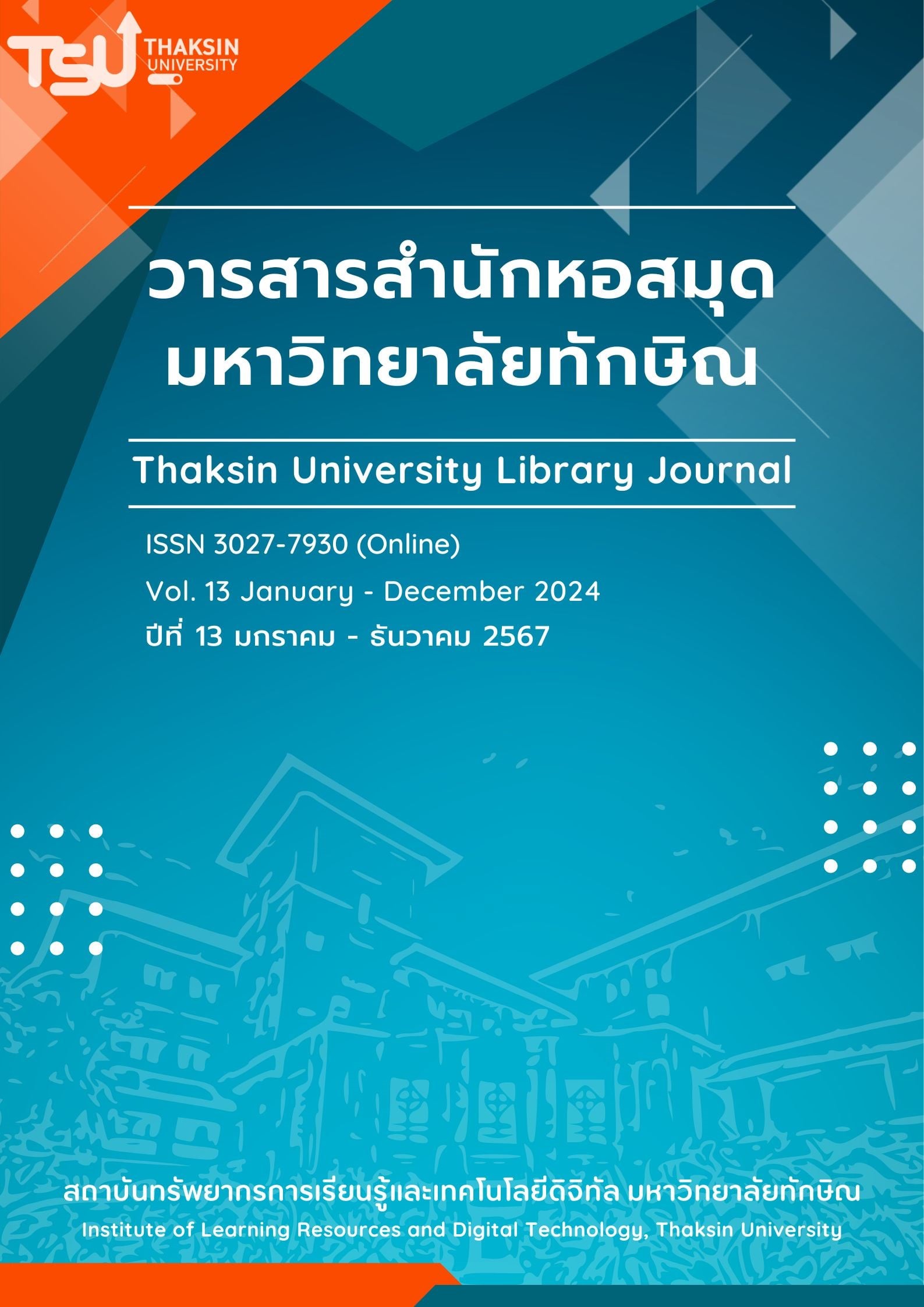Air quality and adverse health effects of personal who exposed to airborne at Library Thaksin University, Phatthalung Campus
Keywords:
Bacteria, Fungi, Air Quality, Health EffectsAbstract
This study is a survey research with the objective to measure the air quality inside the library building. Thaksin University Phatthalung Campus that may affect the health of personnel and service users. The indoor air quality parameters (IAQ) measurement instrument, consisting of an Anderson 1-stage cascade impactor, was used to collect bacteria and fungi samples. The indoor air quality parameters (IAQ) measurement instrument, consisting of an Anderson 1-stage cascade impactor, was used to collect bacteria and fungi samples. and then used to measure the amount of infection along with temperature measurements both inside and outside the building and a questionnaire on health problems of those in the building was used. To interpret the air quality results that affect the recipient exposed to indoor air pollution. There are 2 groups of samples: 20 personnel working within the library and 349 other service users. Statistics used for analysis are frequency (Frequency), percentage (Percentage), mean (Mean) and standard deviation (Standard Deviation) and the Chi-Square Test statistics with a confidence level of 95%. The results of the study showed that the temperature both outside and inside the building. which is an indicator of thermal comfort with a temperature between 24.53-26.4 °C compared to the optimum indoor temperature specified in the Department of Health announcement between 24.0-26.0 °C. Inside the library building, therefore, the temperature is suitable according to the criteria. As for the concentration of bacteria and fungi, none of the areas exceeded the standard, so it did not affect health. But there may be symptoms of Sick Building Syndrome if exposed to bacteria and fungi directly, such as nasal congestion, cough, dry throat, and headache, etc., which will be found among personnel who work more than service users because they spend approximately every day in the building. 7-8 hours.
References
มหาวิทยาลัยทักษิณ, สำนักหอสมุด. (2565). Dashboard : การเข้าใช้บริการห้องสมุด. สืบค้น 20 ตุลาคม 2565, จาก https://shorturl.asia/aRxzu
Archangelidi O, Sathiyajit S, Consonni, D., Jarvis, D., & Matteis, S. (2021). Cleaning products and respiratory health outcomes in occupational cleaners: A systematic review and meta-analysis. Occup Environ Med, 78, 604-617.
Borre, L. V. D., Deboosere, P. (2018). Health risks in the cleaning industry: A belgian census-linked mortality study (1991-2011). Int Arch Occup Environ Health, 91, 13-21.
Department for Education. (2016). Guidelines on ventilation, thermal comfort and indoor air quality in schools. Retrieved July 21, 2022, from https://shorturl.asia/9hbWO
Department of Environmental Quality Promotion. (2015). Knowledge air : Air pollution. Retrieved October 20, 2022, from https://datacenter.deqp.go.th/knowledge
Dhungana P, Chalise M. (2020). Prevalence of sick building syndrome symptoms and its associated factors among bank employees in Pokhara Metropolitan, Nepal. Indoor Air, 30(2), 244-250. Doi:10. 1111/ina.12635
Dhvani P. (2016). Indoor air quality in LEED-Past present and future. Retrieved October 20, 2022, from https://shorturl.asia/2zb4i
Phumas P. (2021). Monitoring of air quality in some classrooms of Faculty of Science and Technology, Chiang Mai Rajabhat. Thai Science and Technology Journal (TSTJ), 29(1), 91-100.
Raju S., Siddharthan T., McCormack M. C. (2020). Indoor air pollution and respiratory health. Clin Chest Med, 41(4), 825-843. Doi:10.1016/j.ccm.2020.08.014
Ritwichai A, Buathong N. (2017). Sick building syndrome and stress among office workers. Chula Med J, 61(4), 525-538.
Svanes, Ø, Bertelsen R. J, Lygre S. H L, Carsin, A. E, Antó, J. M, Forsberg, B., Garcia-Garcia, J. M, Gullón, J. A, Heinrich, J., Holm, M., Kogevinas, M., Urrutia, I., Leynaert, B., Moratalla, J. M, Moual, N. L., Lytras, T., Norbäck, D., Nowak, D., Olivieri, M., Pin, I., Probst-Hensch, N., Schlünssen, V., Sigsgaard, T., Skorge, T. D, Villani, S., Jarvis, D., Zock, J. P, & Svanes, C. (2018). Cleaning at home and at work in relation to lung function decline and airway obstruction. Am J Respir Crit Care Med, 197, 1157-1163.
U.S. Environmental Protection Agency. (2017). Indoor air quality. Retrieved October 2, 2022, from https://www.epa.gov/report-environment/indoor-air-quality
World Health Organization. (2009). Guidelines for indoor air quality :Dampness and mould. Retrieved October 2, 2022, from https://www.who.int/publications/i/item/9789289041683
Yamane, T. (1973). Statistics: An introductory analysis. New York: Harper & Row.
Downloads
Published
How to Cite
Issue
Section
License

This work is licensed under a Creative Commons Attribution-NonCommercial-NoDerivatives 4.0 International License.


